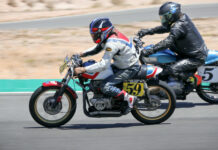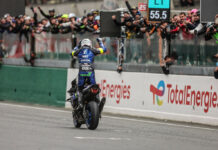Saturday at the Paris Motorcycle Show, BMW Motorrad introduced the third motorcycle in its HP2 (High Performance two-cylinder) series, the Sport, a highly-modified version of the R 1200 S, which is raced in the MOTO-ST endurance series. The HP2 Sport keep the 1170cc (101.0 x 73.0mm bore x stroke), air-and-oil-cooled, opposed Twin (“Boxer”) engine of the R 1200 S, but the engine has been fitted with chain-driven, double overhead cams in place of the High Cam and push rod configuration of the R 1200 S. Each of the horizontal camshafts actuates one 39.0mm (up from 36mm) intake and one 33mm (up from 31mm) exhaust valve via a “drag lever.” Shims under the “drag lever” are used to adjust valve clearance. The four valves in each cylinder head are arranged in a radial fashion. The new cylinder heads also get revised intake porting and carbon covers with replaceable, hard plastic slider/protectors. New forged pistons and new connecting rods are used in the HP2 Sport, but compression ratio remains 12.5:1. While the use of higher-octane fuel is required, only a single spark plug is needed for ignition for each cylinder. Dual throttle bodies measure 52mm and are controlled by BMW’s own closed-loop, BMS-K fuel injection/engine control unit (ECU). A new exhaust system routes the header pipes underneath the engine to a catalytic converter and then up under the self-supporting carbon tail section past an ECU-controlled butterfly valve and on to a dual-outlet stainless steel muffler. Dual oil coolers (one directly behind the other) located behind the two, kidney-shaped intakes in the nose keep oil temperatures in check, which together with the new valve train contributes to a new engine redline, 9500 rpm. Peak horsepower output is claimed to be 128 at 8750 rpm, while peak torque is 84.8 lbs.-ft. at 6000 rpm (up from 122 bhp @ 8250 rpm and 83.0 lbs.-ft. of torque @ 6800 rpm on the R 1200 S). The newest HP2 model gets taller first and second gear ratios, resulting in tighter ratio spacing in its six-speed gearbox. And although the bike does not get a slipper clutch, it is the first production bike to come with an electronic shifter cut-out standard. This “Gearshift Assistant,” as BMW calls it, has a sensor on the shift linkage that cuts spark and fuel when the gear shifter is used to allow faster gear changes without having to back off the throttle or use the clutch lever. If the clutch lever is used, the sensor on the shifter linkage (which is reversible for racing) becomes inactive. Final drive is still via a shaft/single-sided swingarm unit. Wheelbase is 58.5 inches (1487mm), and claimed dry weight is 392 pounds (178 kg), which is much lighter than the 419-pound (190 kg) R 1200 S. Many of the R 1200 S’s chassis components carried over to the HP2 Sport. The tubular steel trellis “midframe” was adapted to work with the self-supporting carbon seat/tail section. The Telelever front and the EVO Paralever rear suspension systems were fitted with three-way-adjustable Ohlins dampers, and both set-ups include ride height adjustability. The forged aluminum wheels measure 3.50 x 17.0 inches front and 6.00 x 17.0 inches rear and will come wearing 120/70-ZR17 and 190/55-ZR17 sport radials, respectively. The front brake system includes dual 320mm (12.6 inches) rotors; radial-mounted, four-piston, monoblock Brembo calipers; steel-braided brake lines and a radial-master cylinder. A single, 265mm (10.4 inches) rotor and twin-piston caliper arrest the rear wheel. The HP2 Sport can be ordered with BMW Motorrad ABS (anti-lock brakes), which can be turned off by the rider. A new, narrower fuel tank (5.3 gallon/20.0 liter capacity) allows the rider to move around the machine better during sport riding or racing and also allows the rider to sit closer to the adjustable, “milled forged” handlebars. Placement of the levers and the foot controls (which include carbon heel guards) is also adjustable. Behind the self-supporting carbon front fairing is an all-digital dashboard manufactured by 2D Systems (a long time supplier to 500cc Grand Prix/MotoGP). Operated by buttons on the left handlebar, the dashboard can display speed, rpm, time of day, fuel range remaining and more in “Road Mode,” and in “Race Mode” it can display and record and download via laptop computer lap times, top speed, maximum revs, number of gear shifts and more. The dash unit also has eight, fully-programmable LEDs that can be used as shift lights or rev counters. Its data logging capabilities can also be expanded by plugging in optional equipment, like a GPS antenna.
BMW Announces HP2 Sport Sportbike At Paris Motorcycle Show
BMW Announces HP2 Sport Sportbike At Paris Motorcycle Show
© 2007, Roadracing World Publishing, Inc.






